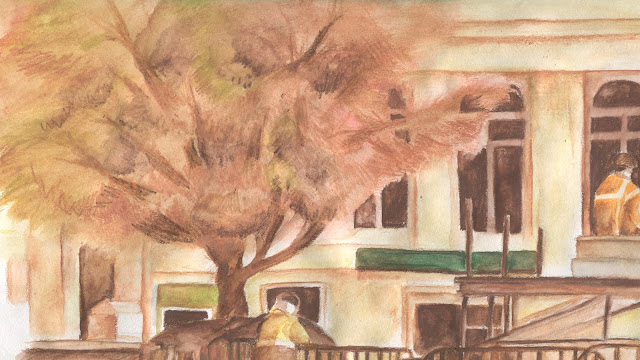With their reputation in having amazing animation and colours in their production, it should came as now surprise that Spirited away , one of studio Ghibli's most prominent work would feature such wonderful sets of background


The first thing to mention , would have to be the colours. Michiyo Yasuda, the late Ghibli's colorist and background artist Kazuo Oga, did an amazing job portraying the youthful and fantasy tones of Miyazaki's story through the use of very vivid colours and contrast, especially in situation where there is a lot of light. Architecture wise, in the two pictures above , Kazuo created a sense of mystery to the scenery , and spirituality (which would be more apparent in the second picture, as the construction mimics that of a temple-like structure, combine with the vastness of the grassfield). When you look at the town, you can sense that it is a place of enjoyment and festivity , with all the lanterns,shops and stalls lining along side the street ( a main street kind of field)


This is even more apparent in the colourful designs of each building in the picture above, a sort of very theme park like environment. So having an effective background like that, means that even when it came to putting characters into the scene ( like the night time scene above ), characters don't have to be portray as doing anything much , but we would still get the idea that they are enjoying themselves in this holiday town, going to food stalls, shops and the bath house. The use of vivid lighting and neon lights in the nightime , combine that with traditional lanterns really gives off that vibe of an old 50s,60s , Shanghai-like town, where western style architecture are given an asian flair. It also helps the emphasise the idea of the shops being an active and moving place, that is welcoming in customers.


Again this is seen in the backgrounds work for the bath house itself. Even before going in , we can get that sense that this is THE place of town , the centre of attention to the story where there is something big going on. This is thanks to the scale and structure of the house itself, design as an large castle-like building that sits alone on an mountain ( very Hogwarts-ish). Its also help by the fact that most of the time, the characters are extremely small , compare to the building in each scene (like the one above ) , and also , that it is usually "framed" from an bottom up angle that further enhance the "grand" feel of it. And of course , in the night time , use of colours really makes the place looks like its bustling and alive ( kinda like a dance club actually ). Its also here that we get that sense of imbedding culture into animation that Anime is known for , through the utilisation of traditional place like bath houses and feudal Japanese architecture, which is unfamiliar to those who are outside of that culture, which in turn further create that sense of fantasy and mystery.



Another thats also very commendable is the use of colour to indicate time and space. In the pictures above , you have an idea of the time of day that picture is set in , thanks to the use of specialize colour palettes , like shades of purple and orange to indicate dusk, when there is an overlay layer of those shades on top of everything ( and even more so for night time when its becomes shades of blue) ,as contrasted by the brightness and distinct , vivid colours of daytime. This sounds easy enough to do but takes alot of colour theory understanding and real world observation


And of course , nothing speak more about the people than their interior design, as seen from above , where the decorated and detailed hallways screams out an aristocrat , or at least someone of high position while the old wooden room is that of your everyday life worker, even a bit worse off if we really get into it .
Overall , theres a characteristic that all Ghibli's films share , that is the attention to details within their background that includes everything from glamour hallways with decorative patterns to large expands of grasslands to a kitchen that is filled with cooking utensils and products. Although generally , less is more , (as it is sometime the case with Ghibli's character design ), A story could be better told to the use of tiny little details






Its beautiful !






















































